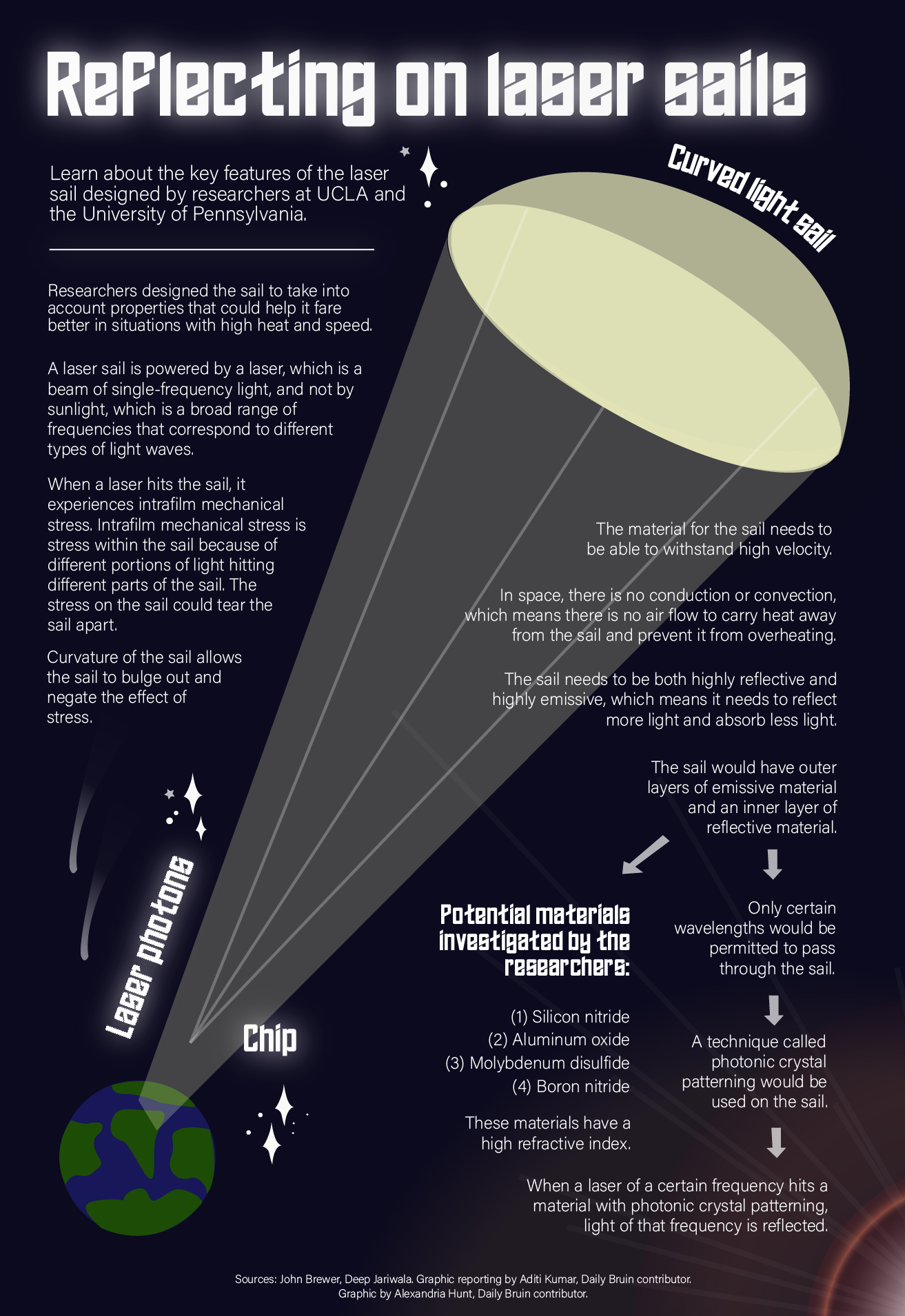Researchers design laser-powered sail for potential use in interstellar travel


By Aditi Kumar
April 14, 2022 11:38 a.m.
This post was updated April 14 at 2:45 p.m.
Researchers from UCLA and the University of Pennsylvania designed a sail that could one day be used to travel to another star system.
In a series of studies published in December and January, researchers outlined important properties the sail would require to withstand interstellar travel.
John Brewer, a doctoral student in material science and engineering at UCLA and co-author of the study, said the sail is a type of light sail powered by a laser, a beam of light with a single frequency. The light particles possess momentum, and when a laser shone from Earth hits the sail, the momentum causes the sail to move.
Brewer said a laser sail is an improvement from rocket propulsion, the conventional method of space travel, which is limited by the amount of fuel a rocket can carry and a rocket’s ability to escape the atmosphere.
However, Deep Jariwala, an assistant professor in electrical and systems engineering at the University of Pennsylvania and co-author of the study, said the sail must survive high-stress situations.
Jariwala added that the laser’s energy and the sail’s high velocity could tear the sail apart if it cannot billow out to handle this stress. The sail’s curved and meshlike design helps resolve this issue, he added.
Aaswath Raman, an assistant professor in materials science and engineering at UCLA and co-author of the study, said the sail should be both extremely large and lightweight to handle stress.
Brewer said in space, where there is no air resistance, the sail can achieve high speeds but would accumulate heat, which could cause it to melt.
“Finding materials that absorb as little (heat) as possible, while also being able to radiate as much (heat) as possible,” Brewer said. “That’s what we’re primarily concerned with.”
He added that the material the researchers designed has outer layers of emissive material – a material that radiates light – and one inner layer of a highly reflective material created through a technique called photonic crystal patterning. Photonic crystal patterning is a method of patterning a material to permit certain frequencies of light to pass through.
Jariwala added that the researchers had investigated materials that are less thick and absorb less heat, including aluminum oxide found in sapphire and 2D materials such as molybdenum disulfide.
Other researchers have previously proposed designs for laser sails. Brewer and Raman said their approach was unique as it aimed to create a sail that could achieve high velocities while handling high levels of stress.
Brewer said researchers have previously aimed to create either a sail that can survive high levels of stress or that can achieve high velocities.
Raman said the research is part of a project called Breakthrough Starshot, which aims to send a laser sail at 20% the speed of light to the Alpha Centauri system, the nearest star system that is 4.37 light years – more than 20 trillion miles – away.
While Jariwala, Brewer and Raman agreed that building a laser sail capable of interstellar travel is not immediately possible, they said scaled-down versions of their laser sails could be built to travel within our solar system.
“Going to interstellar systems is perhaps a very lofty objective, and it may take a long time to realize that,” Jariwala said.
Raman said the researchers’ focus would be on creating scaled-down versions of the sail and testing its properties, such as its ability to handle high temperatures.
Jariwala said the study highlights the importance of improving how a material interacts with light. Without paying attention to these properties, society would not have transatlantic cables or white LED lights, he added.
“Fundamental improvements in material quality, electronic and optical quality can lead to disruptive and transformative technology,” Jariwala said.
Raman added that he believes the study shows interstellar travel could be a reality in the not-so-distant future.
“The whole idea here is that within our lifetimes, we could actually send probes beyond our own solar system, and that is what I think excited people very much because there’s no other realistic way of achieving interstellar travel that we know of,” Raman said.


